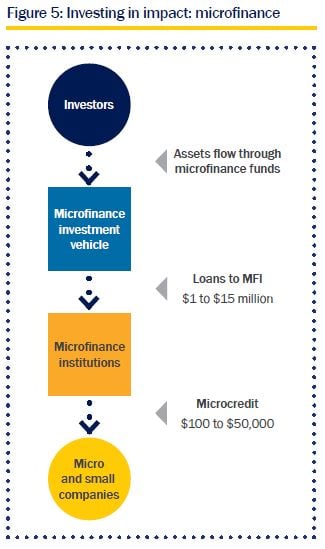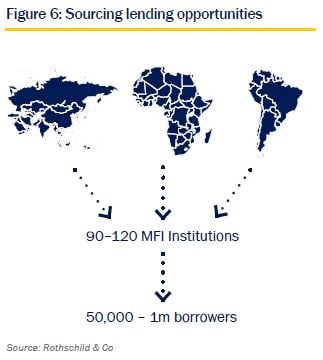Wealth Management: Investment Views – Microfinance as a source of impact

Constantin Augier from our Asset Management division explores impact investing and how we launched a microfinance fund
A-Z of impact investingFrom conservation finance such as the Zoological Society of London's 'rhino impact bond', to microfinance lending such as the R-co 4Change Impact Finance Fund, impact investing is playing an increasingly public role. The green bonds market is estimated to have risen from $50 billion in 2015, to $200 billion from 2015-2019.8 Meanwhile, globally there are some $37 billion invested in microfinance initiatives benefiting some 139 million individuals, overwhelmingly in developing markets such as Africa, Asia and Latin America. Focusing on microfinance, the strategy deploys micro-credits or loans to individuals and small businesses who lack access to conventional capital markets. Whilst the aim is to generate positive social impact through the provision of critical financing to individuals and businesses at a local level, microfinance funds also place a strong emphasis on generating financial returns. These returns have the added benefit of being largely uncorrelated to other financial markets. To invest in microfinance, monies are usually managed through a Microfinance Investment Vehicle (MIV) which pools investors' investable assets. The manager will then provide loans through the MIV to microfinance institutions which in turn issue microcredits to small businesses and bankable projects in need of financing (Figure 5). An example of this type of fund is the R&Co Asset Management R-co 4Change Impact Finance Fund. |
8Climate Bonds Initiative.
Microfinancing has received a fair amount of media coverage in recent years, when did you begin to explore this strategy and create the fund?
We first looked into creating a microfinance fund in 2011. Back then, impact investing was still a relatively niche strategy with fewer opportunities for identifying and lending to credible microfinance institutions. The market's ability to deliver social impact without compromising on financial returns was still in its infancy and clients were understandably cautious. The more pressing inequalities which we now see in the world economy had also not yet come to the forefront of many investors' minds.
In one of the biggest shifts we saw during the decade - we returned to the topic of impact investing in 2017 by which stage client requests for this strategy had become ubiquitous. For many of our clients, generating investment-only returns was no longer a satisfactory end-goal in itself and an increasing number wanted to see their money put to generating a positive social impact. By this stage, the market offered a far greater number of sophisticated partners with which to access the microfinance market and within the year we had partnered with a specialist manager.
Why did you partner with a specialist manager and why specifically Symbiotics?
To identify microfinancing opportunities in the developing world, one needs a large number of specialised resources. This task is made all the more challenging given the need to diversify the number of microfinance institutions we lend to - there are some 90 to 120 such institutions in our portfolio at any one time, selected from at least three continents serving some 50,000 - 1m micro borrowers (Figure 6). Each region we invest in will need some ten analysts covering around 15 microfinance institutions in two to three different countries, requiring site visits and local expertise. It would be an inefficient and costly use of time to try and duplicate these services in-house. We therefore took the prudent step to partner with Symbiotics, a leading European specialist in microfinance based in Geneva.
This leaves us able to focus on our core competencies such as analysing the macro-economic and market environment for the regions we invest in and advising on the structure of the microfinance portfolio in terms of allocation and desired levels of diversification and loan maturities.
Meanwhile Symbiotics can focus on its core competencies, from the due diligence and selection of microfinance institutions we lend to, through to the critical task of measuring the social impact of the fund and those it lends to.
A big question will be how do you measure the 'impact' of the fund?
Measuring impact requires grass-roots, granular research which we obtain through our partnership with Symbiotics. The first step is to review the corporate governance and shareholder structures of the microfinance institutions we lend to. Next, Symbiotics gives a credit rating and then a social impact rating to each microfinance institution based on more than 90 objective criteria. This analysis will incorporate a positive and negative assessment of the institutions' fulfilment of key UN Sustainable Development Goals such as tackling poverty, famine, gender inequality, climate change and promoting clean water and sanitation and responsible consumption and production.
This process will also include looking at the environmental policies and the community engagement of each microfinance institutions we lend to and the social purpose and profile of borrowers they lend to.
It's a complex matrix meaning we produce a full report annually on the impact of the fund, having reviewed the social impact reports for the 80-120 institutions we lend to.
Then of course there is the ongoing monitoring of the fund's impact, which requires monthly meetings with Symbiotics. Through these meetings we can filter the type of microfinance institutions we choose to lend to. For example we selected the ASA India microfinance institution because of its focus on lending to women in rural parts of northern India. With an average loan size of around $200, a microfinance institution like ASA can have a sizeable impact on a large number of micro-entrepreneurs in a developing region, with measurable social as well as financial impact.
How does impact investing balance its quest for financial returns with achieving its impact objectives?
There is a spectrum between focusing on generating impact and delivering financial returns to investors but the two should be mutually achievable. That is why impact investing has developed so rapidly in recent years. For example the R-co 4Change Impact Finance Fund targets a return in US dollars of around 3-4% over the risk free rate, with little-to-no correlation to other major asset classes. We minimise the risk to our financial returns by working with Symbiotics to select microfinance institutions with an average default rate below 1% p.a.
Ultimately, clients are finding that with the right manager, investment strategy and impact analysis, you can achieve both financial returns and have a tangible impact on ESG issues through investing in a microfinance fund.
Click here to continue: Investment Views - Shareholder engagement and activism
In this Investment Views:
- Combining business with humanity: Foreword
- Responsible investments
- ESG in managing wealth
- Microfinance as a source of impact (current page)
- Shareholder engagement and activism
- Important information
Download the full Combining business with humanity in PDF format (3.6 MB)

